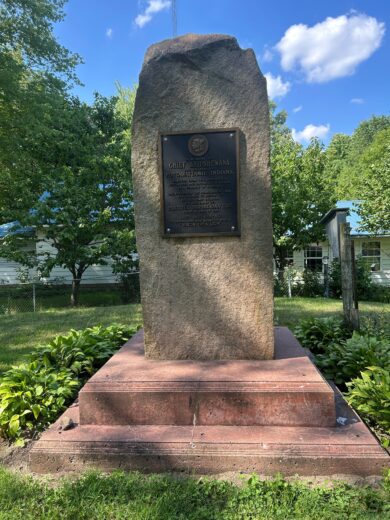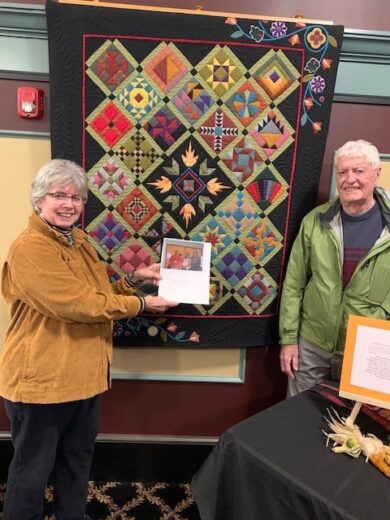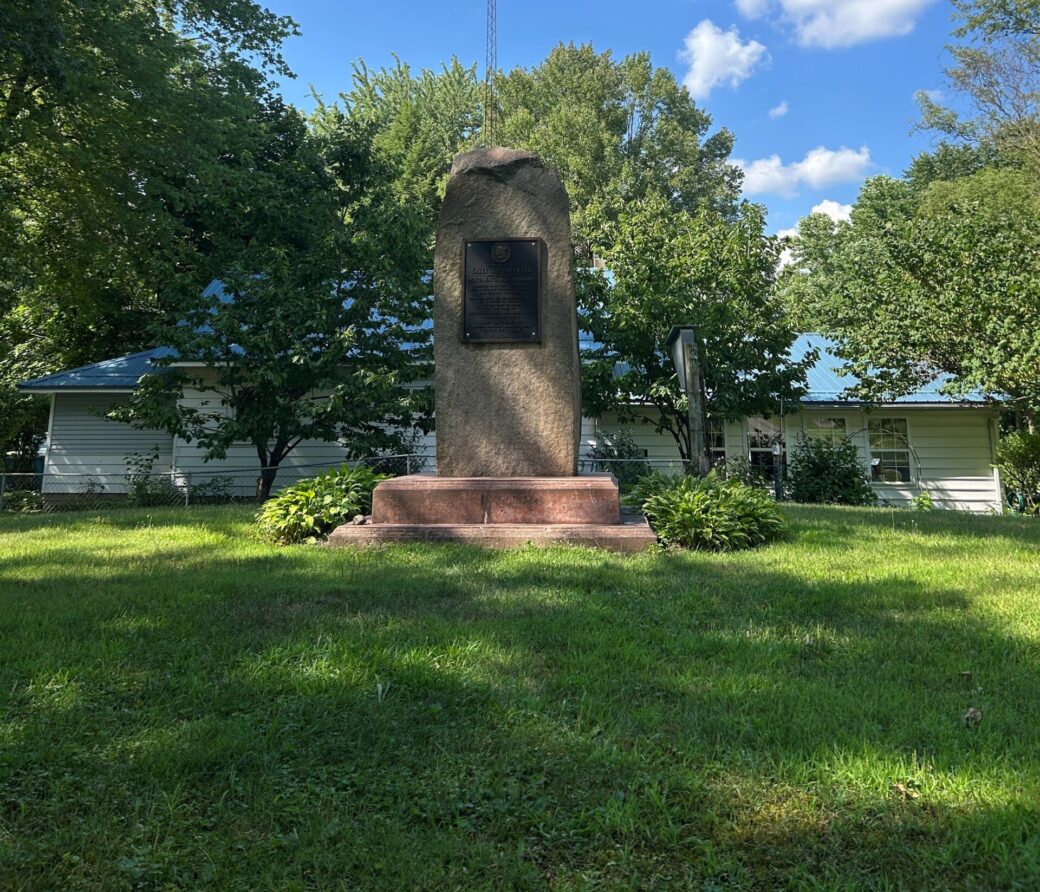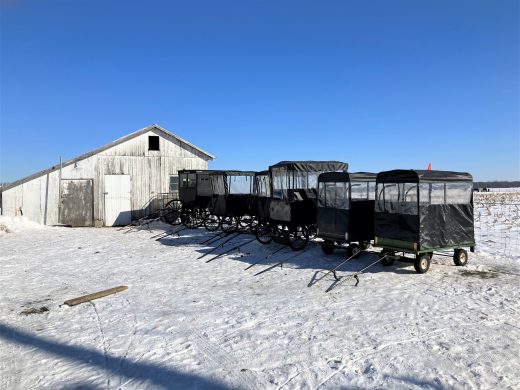
Like other communities throughout the Midwest, the town of Shipshewana bears a name honoring its Native American history. While the community today is synonymous with Amish culture, the name itself evokes a solemn remembrance of the people who first settled in Northern Indiana — in particular, the chief who befriended the European settlers who arrived, whose tribe was forced from their ancestral homes, and who eventually returned to Indiana and to the land he once called home.
Keepers of Sacred Fire
The Potawatomi didn’t always live in Northern Indiana, nor was the tribe confined to this small corner of the state. According to former Shipshewana town manager and local historian Norm Kauffman, one group that settled on the southern shore of Lake Superior, the Anishinaabe, spread east to the Straits of Mackinac, the narrow body of water between Michigan’s Upper and Lower peninsulas that connects Lake Michigan to Lake Huron.
“From there, the Anishinaabe separated into three groups: the Odawa, the Ojibwe, and the Potawatomi,” Kauffman explained. “The Odawa settled in what is now Michigan and Ontario. The Ojibwe and Potawatomi moved southward, wrapping around the southern tip of Lake Michigan, around the Twin Lakes area where Shipshewana now is.”
Recognized as makers of their own fire, the Potawatomi were named “the Keepers of the Sacred Fire” — the Odawa were dubbed “the Keepers of Trade” and the Ojibwe “the Keepers of the Faith.” Forging the Council of Three Fires, the three nations enjoyed centuries of co-existence with one another. While the Potawatomi spread across the Great Lakes region, one tribe found an exceptional spot in what is today the town of Shipshewana. In those days, the region was covered by forests and swamps, sporadically interrupted by flowing streams or lakes — a region brimming with wildlife like deer, bears, otters, beavers, rabbits, waterfowl, and other small game.
For centuries, the Potawatomi made a living off the land as hunter-gatherers. But the arrival of European settlers in the 1800s meant the end of their way of life in one of the most regrettable chapters of American history.
A Friend to All
No one knows exactly when Chief Shipshewana was born — much of his personal history was kept in oral tradition, which was lost after the forced migration of the Potawatomi. As European settlers began effectively squatting on what was then known as the Northwest Territories, those settling in present-day Shipshewana encountered the kindness and generosity of the Chief. Two of those who befriended the chief were Hezekiah and Sarah Davis.
“They exchanged food, friendship. At that point, the Potawatomi made their living off the land — they didn’t own anything,” Kauffman said.
In short order, the demand for land by white settlers led Congress to pass the Indian Removal Act of 1830, signed by then-President Andrew Jackson. Three years later, the Council of Three Fires signed the Chicago Treaty of 1833, in which the three nations ceded 5 million acres of land in the Great Lakes Region to the U.S. government and agreed to move west of the Mississippi River.
On Sept. 4, 1838, a militia of about 100 volunteers rounded up the Chief and his tribe and forced them to march with guns and bayonets to their backs along what came to be known as the Trail of Death to the Osage River in Kansas. Along the way, 41 died; Kauffman recalled some mothers even made the difficult decision to leave their newborn babies with strangers in communities they passed through, believing the children would be better off. Additionally, a young Catholic priest who had befriended the tribe in Indiana, Benjamin Petit, aided them in their journey to Kansas; however, Petit fell ill during the return trip and passed away at what is today Saint Louis University in St. Louis, MO. The group reached their destination in Kansas on Nov. 4, 1838. From there, the tribe, including some of the Chief’s family, split into two bands — the Prairie Band remained in Kansas while the Citizens Band made their way south to Shawnee, OK.
Later, in 1839, the Chief was granted permission to return to his ancestral lands in Northern Indiana, though the reasons for such are unclear. Chief Shipshewana lived for two more years on his native soil and died in 1841. For their part, the Davises witnessed the 1838 roundup; years later, Sarah urged Hezekiah to change the name of the town previously known as Davistown to honor their dear, departed friend — Shipshewana.
Modern Remembrances

Today, Kauffman said, descendants of both Chief Shipshewana and the Potawatomi travel to the town of Shipshewana to visit the land their ancestors once inhabited and the Chief’s grave and learn more about the history of the tribes that lived here. For Kauffman, telling the story of the Potawatomi became personal after speaking with a descendant of the Chief.
“It’s very healing for me to relay this history. When the first descendants came, I spoke to one of them and said, ‘So, what would reparations look like for you, given the history? What could we do?’” Kauffman said. “He said, ‘Well, I don’t expect we’ll get the land back. But it would really be great if we had an honest history told.’ So, that’s what I’ve been doing.”
Reminders of the town’s Native American heritage live on in various ways, Kauffman said, first and foremost at the Chief Shipshewana Memorial, located just south of Shipshewana Lake, marking the spot where the Chief’s body was buried. Another is the Blessing Quilt, which hangs in the Shipshewana Town Hall. Created by artist Rebecca Haarer in 2003, the quilt illustrates the honest history of Shipshewana, including its Native American history through the recreation of Potawatomi beadwork.
“When a Native American visitor from Oklahoma came to Shipshewana, she came with her daughters and grandchildren. She walked in, saw the quilt, and the granddaughters said, ‘Oh, Mommy, there’s our beads and our Ring of Fire!’” Kauffman recounted. “We knew then we had done a fantastic job honoring them, if their own people saw it and recognized it without reading the handout sheet.”


































